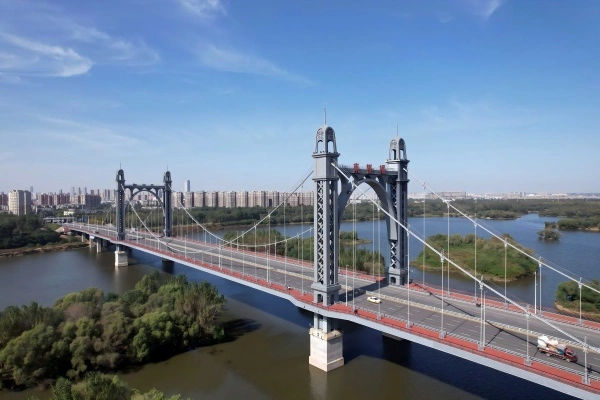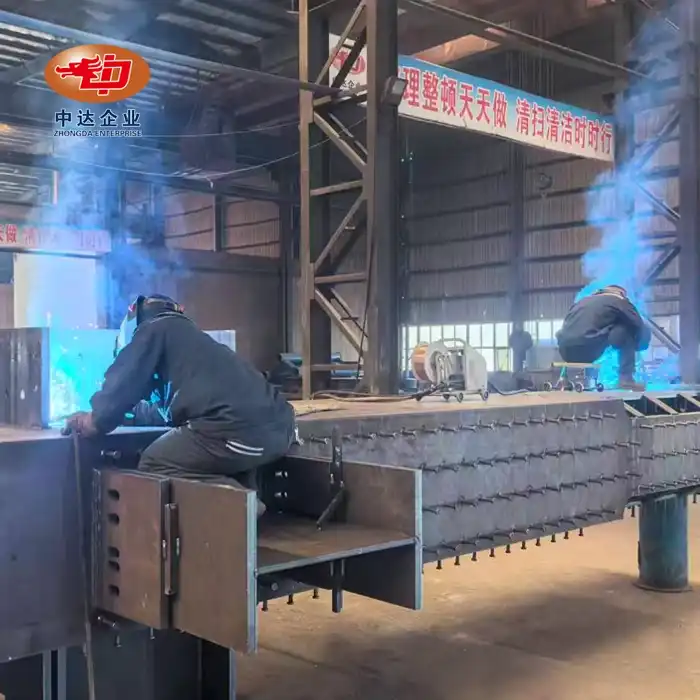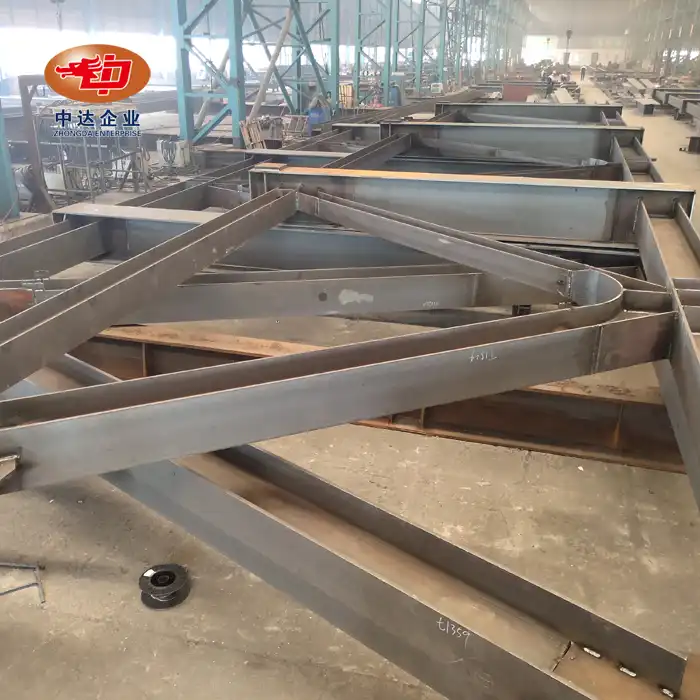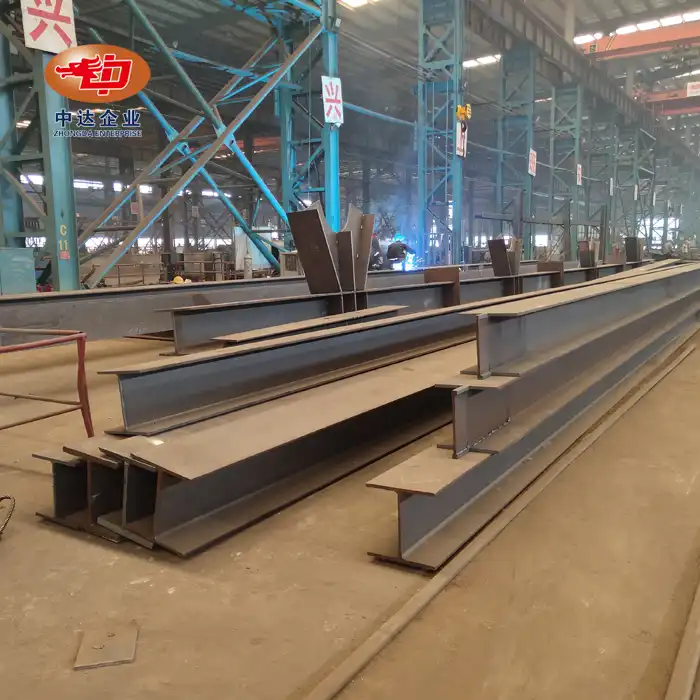Eco-Friendly Construction Techniques in Steel Cable-Stayed Bridges
Factory Prefabrication: Minimizing On-Site Environmental Impact
At Zhongda Steel, we prioritize eco-friendly construction methods in our steel cable-stayed bridge projects. Factory prefabrication stands out as a cornerstone of our green building approach. By manufacturing bridge components in our state-of-the-art 120,000 m² facility, we significantly reduce on-site pollution and waste generation. This method not only streamlines the construction process but also minimizes the ecological footprint at the bridge site.
Our BIM-driven prefabrication technology allows for precise component creation, ensuring each piece fits perfectly upon assembly. This precision reduces material waste and the need for on-site adjustments, further diminishing environmental impact. Moreover, our controlled factory environment enables us to implement stringent quality control measures, enhancing the durability and longevity of bridge components – a key factor in sustainable construction.
Bolted Connections: Reducing Welding Emissions
Another eco-conscious technique we employ is the use of bolted connections instead of traditional welding. This method substantially reduces harmful emissions associated with welding processes. Our advanced bolting techniques ensure structural integrity while promoting cleaner air quality during construction. The reduction in welding fumes not only benefits the environment but also improves working conditions for our construction teams.

Zhongda Steel's innovative bolting solutions incorporate high-strength, precision-engineered fasteners that meet or exceed industry standards. These connections provide excellent load-bearing capacity and fatigue resistance, crucial for the long-term performance of cable-stayed bridges. By opting for bolted connections, we're not just building bridges; we're building a sustainable future.
Compliance with Green Star Ratings
Our commitment to eco-friendly construction extends to ensuring our steel cable-stayed bridges meet or exceed Green Star rating requirements. This comprehensive rating system evaluates the environmental impact of buildings and infrastructure projects. By incorporating energy-efficient designs, using sustainable materials, and implementing waste reduction strategies, our bridges often achieve high Green Star ratings.
Zhongda Steel's dedication to environmental stewardship is reflected in our ISO 14001 certification, which guides our sustainable practices throughout the project lifecycle. From material sourcing to final assembly, we prioritize eco-friendly solutions that contribute to a greener built environment.
Seismic Resilience in Steel Cable-Stayed Bridges
Cable Saddle Splitting Technology: Dispersing Earthquake Energy
Seismic resilience is paramount in bridge design, especially for steel cable-stayed bridges that often span critical transportation arteries. At Zhongda Steel, we employ cutting-edge cable saddle splitting technology to enhance the seismic performance of our bridges. This innovative approach allows for the strategic dispersion of earthquake energy throughout the structure, significantly reducing the risk of catastrophic failure during seismic events.
Our engineers utilize advanced computer modeling and simulation techniques to optimize the cable saddle design. By carefully calibrating the splitting mechanism, we ensure that seismic forces are distributed evenly across the bridge's structural elements. This distribution prevents the concentration of stress at vulnerable points, enhancing the overall resilience of the bridge.
Energy-Dissipating Anchorage Devices
Complementing the cable saddle splitting technology, we integrate energy-dissipating anchorage devices into our bridge designs. These sophisticated components, such as wedge-shaped nuts, play a crucial role in absorbing and dissipating seismic energy. By incorporating these devices at key structural junctions, we significantly enhance the bridge's ability to withstand strong ground motions.
Our proprietary anchorage systems are the result of extensive research and development efforts. They undergo rigorous testing to ensure reliability under extreme conditions. These devices not only improve seismic performance but also contribute to the bridge's overall structural integrity, potentially extending its service life and reducing long-term maintenance costs.
Ensuring Ductile Performance in Magnitude 8.0 Earthquakes
The culmination of our seismic design strategies is the ability of our steel cable-stayed bridges to exhibit ductile performance even during severe magnitude 8.0 earthquakes. Ductility in this context refers to the structure's capacity to undergo significant deformation without collapse, allowing for energy absorption and dissipation during seismic events.
Through a combination of advanced materials, innovative structural configurations, and state-of-the-art design techniques, we ensure that our bridges can withstand extreme seismic loads while maintaining their structural integrity. This level of performance not only safeguards the bridge itself but also protects the lives of those using it during an earthquake, underscoring our commitment to public safety.

Innovative Materials and Technologies for Enhanced Performance
Weathering Steel: Durability in Extreme Conditions
At Zhongda Steel, we push the boundaries of material science to enhance the performance and longevity of our steel cable-stayed bridges. Our proprietary -60°C Weathering Steel Anti-corrosion Technology represents a significant advancement in bridge construction materials. This innovative steel formulation exhibits exceptional resistance to corrosion and degradation, even in the harshest environmental conditions.
The unique properties of our weathering steel allow it to form a protective patina over time, reducing the need for frequent maintenance and repainting. This not only contributes to the bridge's longevity but also minimizes the environmental impact associated with ongoing maintenance activities. Our weathering steel has proven its worth in extreme climates, from the frigid expanses of Arctic Russia to the corrosive marine environments of coastal regions.
Ultra-Thick Plate Cutting Technology
The structural integrity of steel cable-stayed bridges often relies on the precision and quality of their components. Our ultra-thick plate cutting technology, capable of achieving tolerances of ±0.2mm, ensures unparalleled accuracy in fabricating critical bridge elements. This precision is essential for creating perfectly fitting components that enhance the bridge's overall strength and stability.
By utilizing advanced CNC machinery and our proprietary cutting techniques, we can process ultra-thick steel plates with exceptional efficiency and accuracy. This capability allows us to create complex structural elements that are crucial for the unique designs of modern cable-stayed bridges, contributing to both their aesthetic appeal and structural performance.
BIM-Driven Design and Fabrication
Building Information Modeling (BIM) is at the heart of our design and fabrication processes for steel cable-stayed bridges. This advanced digital technology allows us to create highly detailed 3D models of the entire bridge structure, facilitating better coordination between design, fabrication, and construction phases.
Our BIM-driven approach enables us to identify and resolve potential issues early in the design process, reducing errors and minimizing waste during construction. It also allows for precise material quantity calculations, optimizing resource use and further contributing to the project's sustainability. By leveraging BIM technology, we ensure that every component of our bridges is optimized for performance, efficiency, and environmental impact.
Conclusion
Steel cable-stayed bridges represent a pinnacle of modern engineering, seamlessly blending eco-protection with seismic resilience. Through innovative construction techniques, advanced materials, and cutting-edge technologies, these structures meet and often exceed stringent environmental and safety standards. As we continue to push the boundaries of bridge design and construction, the future promises even more sustainable, resilient, and awe-inspiring cable-stayed bridges that will connect communities while preserving our planet.
Contact Us
At Zhongda Steel, we're at the forefront of this evolution in bridge engineering. Our commitment to innovation, quality, and sustainability drives us to create Q420qE steel cable-stayed bridges that are not just structurally sound but also environmentally responsible and seismically resilient. Whether you're planning a new infrastructure project or seeking to upgrade existing structures, our team of experts is ready to provide cutting-edge solutions tailored to your specific needs. Contact us at Ava@zd-steels.com to learn how we can help bring your visionary bridge projects to life, ensuring they stand as testaments to engineering excellence and environmental stewardship for generations to come.














